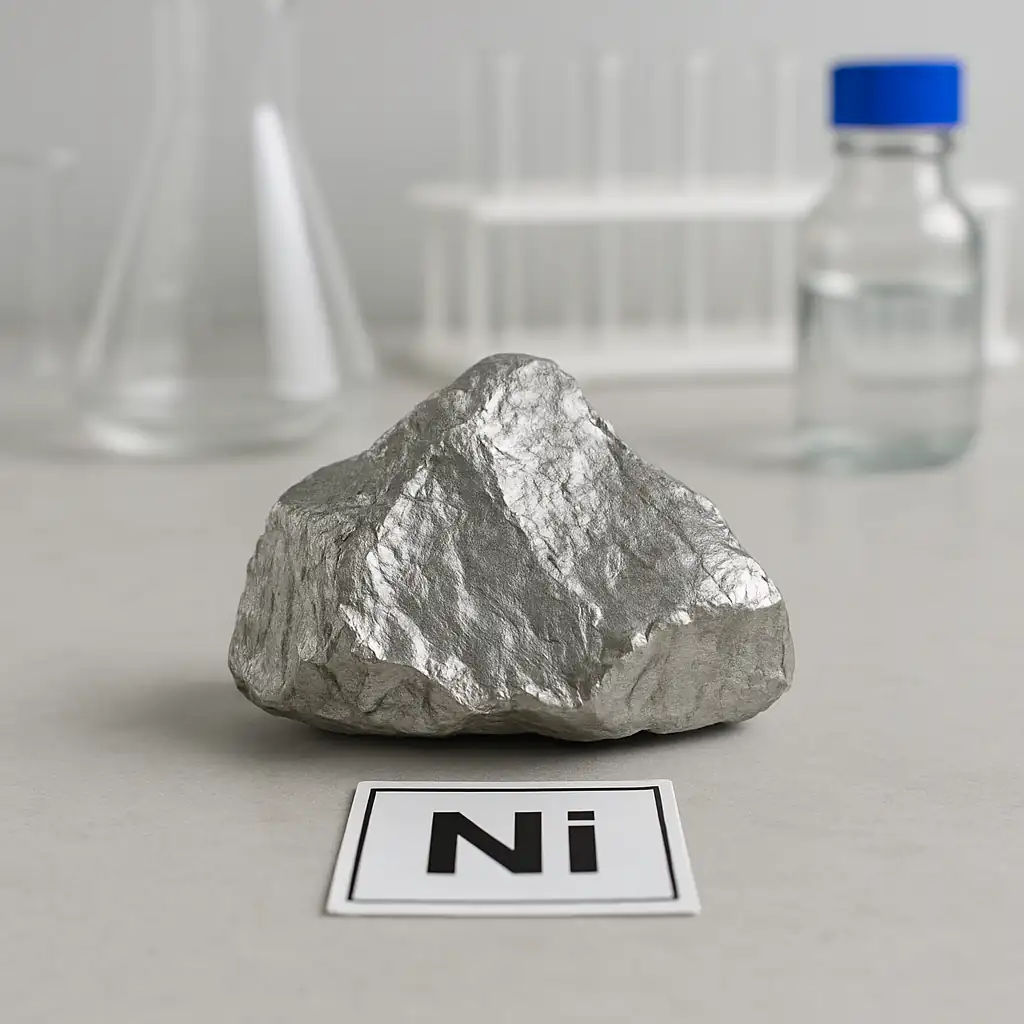Introduction
Nickel stands out as a versatile metal with profound industrial significance. Its unique combination of durability, resistance, and conductivity makes it indispensable across multiple sectors. Nickel properties and uses extend from high-strength alloys to advanced battery technologies, shaping modern manufacturing and energy solutions. This article aims to provide a thorough examination of this element, covering its physical and chemical characteristics, extraction methods, practical applications in alloys, environmental consequences, and the economic benefits it brings. The focus remains on delivering accurate and scientifically grounded insights to enhance understanding.
Found in the Earth’s crust as the 24th most abundant element, nickel often occurs in laterite and sulfide ores. It plays a critical role in technologies like electric vehicles and stainless steel production, reflecting its growing demand. What makes this metal so valuable in these industries? How do its extraction processes and applications impact global markets? Nickel properties and uses offer a window into its multifaceted importance, driving innovation and sustainability efforts worldwide. Let’s explore these aspects with a detailed look at its inherent qualities.
The study of this metal provides valuable knowledge for engineers and scientists alike. Its applications influence daily life and industrial progress. The depth of its impact is worth exploring further. Let’s now delve into its physical and chemical properties in greater detail.

Physical and Chemical Properties of Nickel
Nickel properties and uses are deeply rooted in its exceptional physical characteristics. This silvery-white metal boasts a high melting point of 1455°C, allowing it to withstand extreme heat in industrial settings like furnaces and reactors. With a density of 8.9 g/cm³, it contributes significant weight to structural components, making it ideal for heavy-duty applications. A thin oxide layer forms on its surface, providing excellent corrosion resistance against moisture, air, and even some chemicals. On the Mohs hardness scale, the metal scores around 4, striking a balance between malleability and durability that supports its use in products like coins and industrial equipment.
From a chemical perspective, nickel is classified as a transition metal with an atomic number of 28. Stable compounds, such as nickel sulfate and nickel chloride, are widely used in electroplating and chemical industries for their reliability. Its oxidation states range from 0 to +4, though the +2 state is the most common and stable in natural conditions. The metal reacts slowly with most acids, such as hydrochloric acid, but remains largely inert to alkalis, enhancing its longevity in harsh environments like marine settings. Additionally, its ferromagnetic properties allow it to be magnetized, a trait exploited in electronics, sensors, and magnetic shielding. Nickel properties and uses depend heavily on this chemical versatility, making it a preferred material in diverse applications.
These attributes enable the metal to perform reliably under challenging conditions. It thrives in environments exposed to corrosion or high temperatures, such as chemical plants. Its properties underpin its widespread adoption in technology and manufacturing. Let’s now shift our focus to the methods used to extract this valuable metal from the Earth.
The stability and reactivity of this element drive its industrial appeal. Its physical and chemical profile is a foundation for innovation. These properties naturally lead us to explore nickel mining techniques.

Nickel Mining Techniques
Nickel mining techniques are tailored to the type of ore deposits, primarily sulfide and laterite. Sulfide ores, rich in nickel and often found deep underground, are extracted through traditional underground mining or large-scale open-pit operations. These methods involve drilling and blasting to access the ore, followed by crushing and grinding to prepare it for processing. Laterite ores, which dominate surface deposits in tropical regions, require open-pit mining due to their shallow nature, using heavy machinery to remove overburden and expose the ore. Flotation is a common technique to separate nickel from other minerals, enhancing purity.
Hydrometallurgical processes, such as high-pressure acid leaching, are increasingly applied to laterite ores. This method uses sulfuric acid under high temperature and pressure to dissolve nickel, followed by purification steps to isolate the metal. Smelting, on the other hand, refines sulfide ores into nickel matte, a semi-processed form, through furnaces that remove impurities like sulfur. Environmental controls, including water recycling and dust suppression, are critical to minimize ecological damage during these operations. Nickel mining techniques have evolved with technology, improving efficiency and reducing environmental footprints over time. Major production hubs, such as Canada, Australia, and Indonesia, rely on these methods to meet global demand.
These advancements ensure a consistent nickel supply. They balance economic benefits with environmental stewardship. Mining techniques support the metal’s critical role in industry. Let’s now turn our attention to how nickel is utilized in alloy applications.
Innovation in mining reflects industry needs. These methods sustain nickel’s availability. Their development leads us to explore alloy uses.

Nickel Alloy Applications
Stainless steel, containing 8-10% nickel, exemplifies nickel alloy applications in everyday life, offering rust resistance and strength for cutlery, sinks, and appliances in kitchens worldwide. Inconel alloys, with high nickel content, withstand extreme temperatures up to 1000°C, making them ideal for jet engine components, gas turbines, and aerospace equipment exposed to intense heat. Monel, a nickel-copper alloy, excels in marine settings, resisting saltwater corrosion in ship hulls, propellers, and underwater pipelines, ensuring longevity in harsh conditions. These alloys enhance durability, performance, and reliability across diverse sectors, from construction to transportation.
Beyond alloys, nickel revolutionizes energy storage by improving conductivity in lithium-ion batteries used in electric vehicles and portable electronics like smartphones. Its addition increases battery capacity and lifespan, supporting the global shift to renewable energy and sustainable transport solutions. Coinage, such as the U.S. five-cent piece, relies on copper-nickel blends for durability and resistance to wear, ensuring coins remain functional over decades. In the medical field, nickel alloy applications extend to surgical implants and dental tools, where biocompatibility and corrosion resistance are crucial for patient safety. The global demand for these alloys grows annually, driven by technological advancements, urbanization, and infrastructure needs in developing economies.
These materials meet diverse industrial challenges. They perform reliably under stress, from high heat to corrosive environments. Applications highlight nickel’s economic and technical value. Let’s now consider the environmental implications of its production and use.
Versatility fuels industrial growth. Their widespread use shapes technology. These applications lead us to environmental impacts.

Nickel Environmental Impact
Nickel environmental impact arises primarily from mining and processing activities, which pose challenges to ecosystems if not managed responsibly. Ore extraction generates dust, releasing particulate matter into the air, while greenhouse gases like carbon dioxide are emitted during energy-intensive smelting processes, contributing to climate change. Tailings, the waste left after ore processing, can contaminate soil and water if not properly contained, posing risks to aquatic life, vegetation, and local communities. Acid mine drainage, caused by the reaction of sulfide ores with water and oxygen, further threatens ecosystems by lowering pH levels in rivers and streams, harming fish and other organisms. Mitigation strategies, such as land reclamation, advanced waste treatment, and reforestation, are essential to reduce these effects and restore mined areas.
Recycling offers a sustainable alternative, recovering nickel from scrap metal and used batteries to lessen the need for virgin mining, thereby reducing habitat disruption. However, the disposal of nickel-containing batteries raises concerns about heavy metal leaching into landfills, potentially contaminating groundwater if not handled properly. Sustainable practices, including water recycling, reduced energy use, and cleaner production methods, are being adopted to lower nickel’s environmental footprint. Nickel environmental impact requires ongoing monitoring and regulation to balance industrial benefits with ecological health. Governments and companies collaborate to enforce stricter environmental standards, ensuring responsible mining practices globally.
The impact varies across mining regions like Sudbury in Canada and New Caledonia in the Pacific. Solutions evolve with technological progress, aiming for minimal ecological harm. These considerations shape future policies. Let’s now explore the industrial benefits of nickel.
Awareness drives environmental responsibility. Their management is a global priority. These impacts lead us to industrial advantages.

Leave a Reply